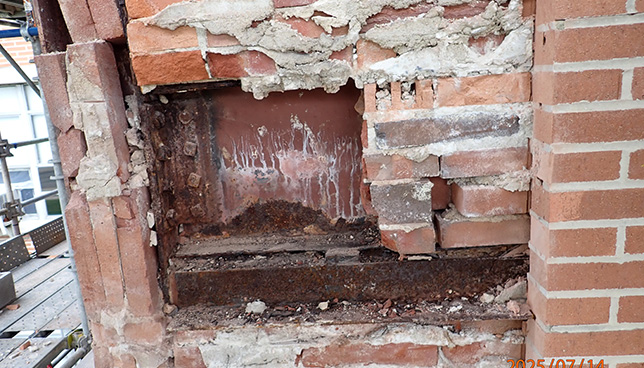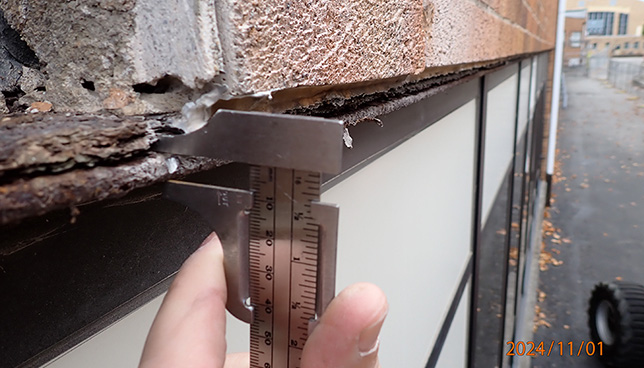Strategic Campus Assessment: Moving Beyond Reactive Maintenance in Educational Facilities
- By Matthew Mowrer
- 09/09/25
A suburban Pennsylvania K-12 school served its community faithfully for decades. From the ground, its brick façade appeared solid and well-maintained, but when facilities managers noticed some surface cracking, they took the proactive step of commissioning a comprehensive façade assessment. The evaluation revealed that extensive shifting had occurred over time, a common issue with buildings from that era where two factors often converge: the natural corrosion of steel components and archaic construction methods that didn't fully account for differential material movement.
This scenario illustrates both a challenge and an opportunity facing educational facility managers today. While campuses may appear stable on the surface, building systems naturally evolve over time, and proactive assessment can identify developing issues before they become expensive emergencies. The question isn't whether aging educational facilities need attention. It's how institutions can transition from costly reactive maintenance to strategic asset management in a way that protects both budgets and communities.
The Educational Facilities Paradox
Educational institutions face a unique set of pressures that complicate facility management decisions. Unlike commercial properties, schools and universities must balance infrastructure needs against their primary mission: education. When faced with competing priorities, decision-makers naturally gravitate toward investments that directly enhance learning outcomes rather than preventive building maintenance.
This creates a challenging dynamic. A multi-million repair budget may be approved, but the reality of educational calendars means much of that work must be compressed into summer break windows. The compressed timeline limits what can actually be accomplished, often forcing facilities teams to defer comprehensive repairs in favor of immediate fixes.
Educational budgets prioritize investments that improve education, often leaving limited resources for facilities managers advocating for safety and high-priority maintenance projects. Meanwhile, deferred maintenance creates a cascade effect where single deterioration issues lead to additional problems in surrounding building elements, ultimately increasing both costs and risks.
 Common steel corrosion
Common steel corrosion
Image courtesy of O'Donnell & Naccarato
Tailored Assessment Methodology for Active Learning Environments
Conducting comprehensive assessments on active educational campuses requires specialized approaches that minimize disruption while maximizing safety. The process begins long before field teams arrive on site.
Pre-assessment coordination is crucial. Beyond understanding building systems and historical maintenance records, successful assessments require awareness of campus events that could restrict access or create conflicts. Campus celebrations, athletic events, and academic ceremonies can limit street access and affect scheduling, while early morning work, though beneficial for avoiding traffic, must be balanced against noise concerns for nearby residential areas.
Security considerations differ significantly between K–12 and higher education environments. While both sectors typically request work during breaks or off-hours, K–12 facilities often require enhanced communication protocols. Professional assessment tools like cameras, binoculars, and drones can appear suspicious in school environments, making advance notification and coordination with security personnel essential.
Technology plays an increasingly important role in minimizing campus disruption. Drones have emerged as particularly valuable tools, often supplementing or even replacing hands-on assessments in hard-to-reach areas. Advanced drone capabilities extend beyond visual inspection. Thermal imaging helps identify building enclosure issues, while scanning technology can create detailed documentation for buildings lacking original drawings. This digital capture can be converted into Building Information Modeling (BIM) systems, providing crucial documentation for future repair programs.
However, specialized educational spaces require customized approaches. Long, open areas like gymnasiums and auditoriums present access challenges due to high ceilings, while confined laboratory spaces may be difficult to assess due to critical MEP components that cannot be disturbed. Each structural and enclosure system demands individual consideration based on its unique characteristics and constraints. One particularly helpful tool is a borescope. This snake-like camera can access hard to reach places with minimal impact to the structure, allowing a view of hidden conditions.
Strategic Implementation and Stakeholder Communication
Educational facility assessments must ultimately serve decision-makers who may not have technical backgrounds but hold fiduciary responsibility for campus safety and stewardship. Effective communication strategies focus on clarity and visual documentation.
Clear photographs linked to specific locations prove invaluable when presenting findings to school boards or trustees. A picture conveys more than technical analysis alone, and location-specific documentation allows stakeholders to personally verify concerns. While board members may not understand the engineering analysis behind deterioration, they can usually recognize when something appears wrong.
When funding limitations require prioritization, a systematic approach helps facilities managers make defensible decisions. Safety considerations always take precedence, but temporary protective measures, such as sidewalk bridging, netting, or site fencing, can provide interim protection until formal repairs become feasible. Access considerations follow safety priorities: addressing easily accessible items first can serve as pilot programs that inform approaches for more complex repairs. Finally, remaining service-life assessments help balance urgency with available resources.
 Measurement of built-up corrosion and O&N remaining material thickness to determine section loss using a caliper
Measurement of built-up corrosion and O&N remaining material thickness to determine section loss using a caliper
Image courtesy of O'Donnell & Naccarato
Long-term Value and Cost Management
Proactive assessment programs deliver measurable value beyond immediate safety improvements. Access costs typically represent the largest single expense in repair programs, making strategic bundling crucial for fiscal efficiency. When scaffolding, boom lifts, or specialized access equipment are already in place, addressing both critical repairs and general maintenance items in the same area maximizes the investment while extending overall service life.
This approach requires assessments that look beyond immediate problems to identify maintenance needs that will prevent future deterioration. For example, when building systems show signs of natural aging, like the steel components in the Pennsylvania school façade, early identification through assessment allows for planned maintenance interventions that are typically more cost-effective than waiting for more extensive repairs to become necessary.
Regular reassessment cycles help institutions stay ahead of deterioration curves. Vulnerable or deteriorating structures benefit from evaluation every two years, while more critical systems can be assessed on five-year cycles. Between formal assessments, temporary measures like protective coatings, netting, or sealants can slow deterioration and extend intervals between major repairs.
Developing Internal Capacity
Successful facilities management extends beyond individual assessments to developing institutional knowledge and capacity. When selecting assessment consultants, facilities managers should prioritize those with familiarity working in similar educational environments. Consultants with design experience often bring valuable perspectives on repair strategies, having worked with these building systems during original construction.
Reference checking remains essential, but equally important is ensuring consultants understand the unique operational requirements of educational environments. Academic calendars, security protocols, and stakeholder communication needs require specialized experience that goes beyond technical competence.
A Foundation for Strategic Stewardship
Campus-wide assessments provide the foundation for strategic stewardship that protects educational missions while safeguarding the communities that depend on these facilities. The difference between reactive and proactive maintenance often comes down to having reliable information when decisions need to be made. No building waits for the perfect budget cycle to need repairs, but institutions equipped with comprehensive assessment data can respond strategically rather than reactively.
For educational facility managers considering campus-wide assessment, the question isn't whether buildings will need attention, it's whether institutions will be prepared to respond effectively when that need arises. Sometimes the most important step in protecting a campus isn't the first repair that gets made but simply understanding current conditions and developing a strategic plan forward.